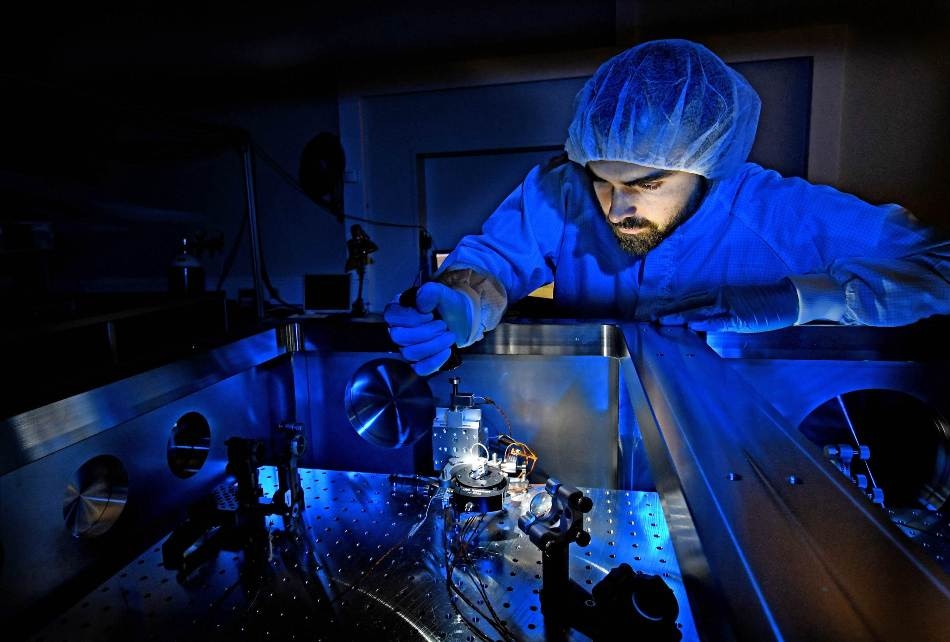Jan 24 2019
For the first time, dissipative solitons have been produced in passive, free-space resonators by laser physicists from the Laboratory for Attosecond Physics run by the Max Planck Institute of Quantum Optics as well as the Ludwig-Maximilian University.
 Development of new enhancement cavities at the Laboratory for Attosecond Physics. (Image credit: Thorsten Naeser)
Development of new enhancement cavities at the Laboratory for Attosecond Physics. (Image credit: Thorsten Naeser)
Of all waveforms, solitons are the most stable. While all other waveforms tend to get dispersed under certain conditions, a soliton continues unperturbed on its solitary way, without even the slightest of change in its velocity or shape. Due to their self-stabilizing properties, solitons are of huge significance to the field of laser optics, specifically for generating ultrashort light pulses.
Currently, a team headed by Dr Ioachim Pupeza from the Laboratory of Attosecond Physics (LAP) in Munich, which is jointly run by the Max Planck Institute of Quantum Optics (MPQ) and the Ludwig-Maximilian University (LMU), has generated, for the first time, optical solitons in passive, free-space resonators. Using the technique, laser pulses can be compressed while increasing their peak power, paving the way for innovative applications for free-space enhancement cavities in the investigation of ultrafast dynamics and in precision spectroscopy.
The formation of a solitary water wave in a canal was first observed in 1834 by John Scott Russell, a young engineer, in Edinburgh. By following it on horseback, he discovered that it propagated at a stable velocity for many miles without any change in its form. In order to examine the phenomenon, he even constructed a water tank in his garden. However, he would not have predicted the ensuing importance of this “soliton” waveform for branches of physics apart from the field of fluid dynamics. At present, optical solitons are an unavoidable component of laser technology, specifically for investigating ultrafast dynamics and quantum optics.
Physicists at the Laboratory for Attosecond Physics have now been successful in generating temporal optical solitons in a passive, free-space resonator. They achieved this by coupling 350-fs infrared laser pulses with a wavelength of 1035 nm and a repetition rate of 100 MHz into a newly developed passive optical resonator built with four mirrors and a thin sapphire plate.
The passage of the electromagnetic field of the optical pulse causes a non-linear change in the refractive index of the crystal. This results in a dynamic phase shift, which fully compensates for the dispersion that occurs in the resonator, while at the same time broadening the spectrum of the pulse.
Nikolai Lilienfein, Study First Author, Max Planck Institute of Quantum Optics
As the simultaneously interferometrically coupled laser source compensates for the power losses that unavoidably occur in the resonator, in principle, a soliton has the ability to circulate ad infinitum in the resonator. Moreover, the team devised a highly efficient technique for controlling the energy input to the cavity soliton. When used together, these measures enabled the physicists to compress the input pulse duration by nearly an order of magnitude to 37 fs, while improving their peak power by a factor of 3200.
This enhancement-resonator technology paves a new path for producing trains of high-precision extreme ultraviolet (XUV) attosecond pulses—an attosecond lasts for one-billionth of one-billionth of 1 second. Using this, researchers could in turn characterize the dynamics of subatomic processes—specifically in observing the motions of electrons—in much greater detail than was feasible previously.
“Over the past several years, we have been able to make the unique advantages of enhancement resonators available for experiments in attosecond physics. This new technique opens a path towards further significant advances in the pulse power and stability attainable with such systems, while at the same time reducing the complexity of the experimental setup,” stated Dr Ioachim Pupeza, leader of the team responsible for the new study in the LAP. These enhancements would also be advantageous against the backdrop of XUV frequency-comb spectroscopy, which is key to the creation of a new generation of optical clocks based on quantum transitions that occur in atomic nuclei.